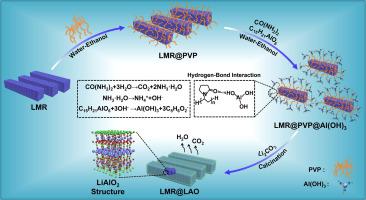当前位置:
X-MOL 学术
›
Chem. Eng. Sci.
›
论文详情
Our official English website, www.x-mol.net, welcomes your feedback! (Note: you will need to create a separate account there.)
PVP-bridged γ-LiAlO2 nanolayer on Li1.2Ni0.182Co0.08Mn0.538O2 cathode materials for improving the rate capability and cycling stability
Chemical Engineering Science ( IF 4.7 ) Pub Date : 2021-01-01 , DOI: 10.1016/j.ces.2020.116126 Weijian Tang , Zhangxian Chen , Haijian Huang , Muhammad Irfan , Cheng Huang , Zeheng Yang , Weixin Zhang
Chemical Engineering Science ( IF 4.7 ) Pub Date : 2021-01-01 , DOI: 10.1016/j.ces.2020.116126 Weijian Tang , Zhangxian Chen , Haijian Huang , Muhammad Irfan , Cheng Huang , Zeheng Yang , Weixin Zhang

|
Abstract Li-rich layered materials have been considered as promising cathode materials for next-generation lithium-ion batteries due to their high capacity (≥250 mAh g−1). Unfortunately, this type of cathode material still suffers from intrinsic deficiencies of capacity fading and side reactions. Surface coating with a protective layer can resolve the above problems to some extent, whereas normal coating strategies still suffer from process complexity and are difficult to prevent phase separation that leads to the formation of an independent miscellaneous phase. Herein, we report an effective PVP-bridged coating method, in which the PVP molecules can bridge the gap between the coating shell and the electrode material core through hydrogen bonding and functional groups. Utilizing this strategy, a uniform Li-ion conductor γ-LiAlO2 nanolayer with a thickness of 7 nm is successfully formed on the surface of the Li1.2Ni0.182Co0.08Mn0.538O2 cathode material, which leads to an excellent rate capability (177.0 mAh g−1 delivered at 5 C) and superior cycling stability (89.3% capacity retention achieved after 100 cycles at 10 C) for the composite material. Furthermore, the exothermic reaction for the composite material takes place at a higher temperature (234.1 °C) relative to the uncoated sample (220.9 °C), implying its improved thermal stability. Galvanostatic intermittent titration technique and density functional theory calculation demonstrate a higher Li+ diffusion coefficient for the γ-LiAlO2 coated sample and a lower Li+ diffusion energy barrier in γ-LiAlO2. Based on the promising results, the PVP-bridged coating strategy presented in this study provides a new perspective in material design towards high-performance Li-rich cathode materials for lithium-ion batteries.
中文翻译:

Li1.2Ni0.182Co0.08Mn0.538O2正极材料上PVP桥接γ-LiAlO2纳米层提高倍率性能和循环稳定性
摘要 富锂层状材料因其高容量(≥250 mAh g-1)而被认为是下一代锂离子电池有前途的正极材料。不幸的是,这种类型的正极材料仍然存在容量衰减和副反应的内在缺陷。带有保护层的表面涂层可以在一定程度上解决上述问题,而普通的涂层策略仍然存在工艺复杂性,并且难以防止导致形成独立杂相的相分离。在此,我们报告了一种有效的 PVP 桥接涂层方法,其中 PVP 分子可以通过氢键和官能团来桥接涂层壳和电极材料核之间的间隙。利用这个策略,在 Li1.2Ni0.182Co0.08Mn0.538O2 正极材料表面成功形成了厚度为 7 nm 的均匀锂离子导体 γ-LiAlO2 纳米层,这导致了优异的倍率性能(177.0 mAh g-1在 5 C 下)和复合材料的优异循环稳定性(在 10 C 下循环 100 次后达到 89.3% 的容量保持率)。此外,复合材料的放热反应发生在相对于未涂层样品 (220.9 °C) 更高的温度 (234.1 °C),这意味着其热稳定性得到改善。恒电流间歇滴定技术和密度泛函理论计算表明,γ-LiAlO2 涂层样品的 Li+ 扩散系数较高,γ-LiAlO2 中的 Li+ 扩散能垒较低。基于有希望的结果,
更新日期:2021-01-01
中文翻译:

Li1.2Ni0.182Co0.08Mn0.538O2正极材料上PVP桥接γ-LiAlO2纳米层提高倍率性能和循环稳定性
摘要 富锂层状材料因其高容量(≥250 mAh g-1)而被认为是下一代锂离子电池有前途的正极材料。不幸的是,这种类型的正极材料仍然存在容量衰减和副反应的内在缺陷。带有保护层的表面涂层可以在一定程度上解决上述问题,而普通的涂层策略仍然存在工艺复杂性,并且难以防止导致形成独立杂相的相分离。在此,我们报告了一种有效的 PVP 桥接涂层方法,其中 PVP 分子可以通过氢键和官能团来桥接涂层壳和电极材料核之间的间隙。利用这个策略,在 Li1.2Ni0.182Co0.08Mn0.538O2 正极材料表面成功形成了厚度为 7 nm 的均匀锂离子导体 γ-LiAlO2 纳米层,这导致了优异的倍率性能(177.0 mAh g-1在 5 C 下)和复合材料的优异循环稳定性(在 10 C 下循环 100 次后达到 89.3% 的容量保持率)。此外,复合材料的放热反应发生在相对于未涂层样品 (220.9 °C) 更高的温度 (234.1 °C),这意味着其热稳定性得到改善。恒电流间歇滴定技术和密度泛函理论计算表明,γ-LiAlO2 涂层样品的 Li+ 扩散系数较高,γ-LiAlO2 中的 Li+ 扩散能垒较低。基于有希望的结果,



























 京公网安备 11010802027423号
京公网安备 11010802027423号